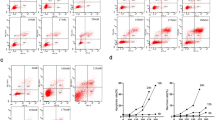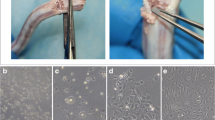Abstract
Purpose
Intervertebral disc cell apoptosis has been suggested to play a key role in promoting disc degeneration, and many studies have shown that the mechanism may be related to oxidative stress. Pyrroloquinoline quinone (PQQ), a redox cofactor for bacterial dehydrogenases, possesses the potential to scavenge reactive oxygen species (ROS) and inhibit cell apoptosis. The objective of this study was to evaluate the effects of PQQ on cultured rat nucleus pulposus (NP) cells under conditions of oxidative injury induced by hydrogen peroxide (H2O2) and to investigate the underlying mechanisms in vitro.
Methods
Cell viability was determined by CCK8 assay. Changes in the apoptosis rate, intracellular ROS levels and the mitochondrial membrane potential were measured by flow cytometry. Extracellular matrix (ECM)-related proteins (collagen-2 and aggrecan) and apoptosis-related proteins (Bcl-2, Bax, cytochrome c, and caspase-3) were investigated by western blotting.
Results
The results show that NP cells pretreated with PQQ before H2O2 exposure exhibited increased cell viability, decreased ROS formation, maintained mitochondrial membrane potential, and reduced apoptosis. In the presence of PQQ, ECM production was maintained by the cells despite being in an apoptotic environment. In addition, pretreatment with PQQ increased the expression of Bcl-2, inhibited the release of mitochondrial cytochrome c, and decreased the expressions of Bax and cleaved caspase-3.
Conclusions
Our results suggest that PQQ can protect rat NP cells against oxidative stress via a mitochondria-mediated pathway. PQQ might be useful as a potential pharmaceutical agent in the prevention of intervertebral disc degeneration.





Similar content being viewed by others
References
Wai EK, Roffey DM, Bishop P, Kwon BK, Dagenais S (2010) Causal assessment of occupational lifting and low back pain: results of a systematic review. Spine J 10:554–566
Roberts S, Evans H, Trivedi J, Menage J (2006) Histology and pathology of the human intervertebral disc. J Bone Joint Surg Am 88(Suppl 2):10–14
Ding F, Shao ZW, Yang SH, Wu Q, Gao F, Xiong LM (2012) Role of mitochondrial pathway in compression-induced apoptosis of nucleus pulposus cells. Apoptosis 17:579–590
Sudo H, Minami A (2011) Caspase 3 as a therapeutic target for regulation of intervertebral disc degeneration in rabbits. Arthritis Rheum 63:1648–1657
Wei A, Brisby H, Chung SA, Diwan AD (2008) Bone morphogenetic protein-7 protects human intervertebral disc cells in vitro from apoptosis. Spine J 8:466–474
Kim KW, Ha KY, Lee JS, Rhyu KW, An HS, Woo YK (2007) The apoptotic effects of oxidative stress and antiapoptotic effects of caspase inhibitors on rat notochordal cells. Spine (Phila Pa 1976) 32:2443–2448
Nasto LA, Robinson AR, Ngo K, Clauson CL, Dong Q, St CC, Sowa G, Pola E, Robbins PD, Kang J, Niedernhofer LJ, Wipf P, Vo NV (2013) Mitochondrial-derived reactive oxygen species (ROS) play a causal role in aging-related intervertebral disc degeneration. J Orthop Res 31:1150–1157
Poveda L, Hottiger M, Boos N, Wuertz K (2009) Peroxynitrite induces gene expression in intervertebral disc cells. Spine (Phila Pa 1976) 34:1127–1133
Ye J, Li J, Yu Y, Wei Q, Deng W, Yu L (2010) l-carnitine attenuates oxidant injury in HK-2 cells via ROS-mitochondria pathway. Regul Pept 161:58–66
Ali R, Le Maitre CL, Richardson SM, Hoyland JA, Freemont AJ (2008) Connective tissue growth factor expression in human intervertebral disc: implications for angiogenesis in intervertebral disc degeneration. Biotech Histochem 83:239–245
Li X, Phillips FM, An HS, Ellman M, Thonar EJ, Wu W, Park D, Im HJ (2008) The action of resveratrol, a phytoestrogen found in grapes, on the intervertebral disc. Spine (Phila Pa 1976) 33:2586–2595
Cheng YH, Yang SH, Lin FH (2011) Thermosensitive chitosan-gelatin-glycerol phosphate hydrogel as a controlled release system of ferulic acid for nucleus pulposus regeneration. Biomaterials 32:6953–6961
Zhang Q, Ding M, Cao Z, Zhang J, Ding F, Ke K (2013) Pyrroloquinoline quinine protects rat brain cortex against acute glutamate-induced neurotoxicity. Neurochem Res 38:1661–1671
Tao R, Karliner JS, Simonis U, Zheng J, Zhang J, Honbo N, Alano CC (2007) Pyrroloquinoline quinone preserves mitochondrial function and prevents oxidative injury in adult rat cardiac myocytes. Biochem Biophys Res Commun 363:257–262
Hobara N, Watanabe A, Kobayashi M, Tsuji T, Gomita Y, Araki Y (1988) Quinone derivatives lower blood and liver acetaldehyde but not ethanol concentrations following ethanol loading to rats. Pharmacology 37:264–267
Shankar BS, Pandey R, Amin P, Misra HS, Sainis KB (2010) Role of glutathione in augmenting the anticancer activity of pyrroloquinoline quinone (PQQ). Redox Rep 15:146–154
Hamagishi Y, Murata S, Kamei H, Oki T, Adachi O, Ameyama M (1990) New biological properties of pyrroloquinoline quinone and its related compounds: inhibition of chemiluminescence, lipid peroxidation and rat paw edema. J Pharmacol Exp Ther 255:980–985
Xiong XH, Zhao Y, Ge X, Yuan SJ, Wang JH, Zhi JJ, Yang YX, Du BH, Guo WJ, Wang SS, Yang DX, Zhang WC (2011) Production and radioprotective effects of pyrroloquinoline quinone. Int J Mol Sci 12:8913–8923
Yang L, Zhu L, Dong W, Cao Y, Lin L, Rong Z, Zhang Z, Wu G (2013) Reactive oxygen species-mediated mitochondrial dysfunction plays a critical role in high glucose-induced nucleus pulposus cell injury. Int Orthop. doi:10.1007/s00264-013-2144-6
Park EY, Park JB (2013) High glucose-induced oxidative stress promotes autophagy through mitochondrial damage in rat notochordal cells. Int Orthop. doi:10.1007/s00264-013-2037-8
Zhang Q, Shen M, Ding M, Shen D, Ding F (2011) The neuroprotective action of pyrroloquinoline quinone against glutamate-induced apoptosis in hippocampal neurons is mediated through the activation of PI3 K/Akt pathway. Toxicol Appl Pharmacol 252:62–72
Misra HS, Rajpurohit YS, Khairnar NP (2012) Pyrroloquinoline-quinone and its versatile roles in biological processes. J Biosci 37:313–325
He K, Nukada H, Urakami T, Murphy MP (2003) Antioxidant and pro-oxidant properties of pyrroloquinoline quinone (PQQ): implications for its function in biological systems. Biochem Pharmacol 65:67–74
Min Z, Wang L, Jin J, Wang X, Zhu B, Chen H, Cheng Y (2014) Pyrroloquinoline quinone induces cancer cell apoptosis via mitochondrial-dependent pathway and down-regulating cellular Bcl-2 protein expression. J Cancer 5:609–624
van Kleef MA, Jongejan JA, Duine JA (1989) Factors relevant in the reaction of pyrroloquinoline quinone with amino acids. Analytical and mechanistic implications. Eur J Biochem 183:41–47
Casini A, Finazzi-Agro A, Sabatini S, El-Sherbini ES, Tortorella S, Scipione L (1999) Role of calcium in the reaction between pyrroloquinoline quinone and pyridine nucleotides monomers and dimers. Arch Biochem Biophys 368:385–393
Rodriguez E, Roughley P (2006) Link protein can retard the degradation of hyaluronan in proteoglycan aggregates. Osteoarthritis Cartilage 14:823–829
Xu F, Yu H, Liu J, Cheng L (2013) Pyrroloquinoline quinone inhibits oxygen/glucose deprivation-induced apoptosis by activating the PI3 K/AKT pathway in cardiomyocytes. Mol Cell Biochem. doi:10.1007/s11010-013-1849-6
Rahman MA, Kim NH, Yang H, Huh SO (2012) Angelicin induces apoptosis through intrinsic caspase-dependent pathway in human SH-SY5Y neuroblastoma cells. Mol Cell Biochem 369:95–104
Nguyen KC, Willmore WG, Tayabali AF (2013) Cadmium telluride quantum dots cause oxidative stress leading to extrinsic and intrinsic apoptosis in hepatocellular carcinoma HepG2 cells. Toxicology 306:114–123
Conflict of interest
The authors declare no conflict of interest.
Author information
Authors and Affiliations
Corresponding authors
Rights and permissions
About this article
Cite this article
Yang, L., Rong, Z., Zeng, M. et al. Pyrroloquinoline quinone protects nucleus pulposus cells from hydrogen peroxide-induced apoptosis by inhibiting the mitochondria-mediated pathway. Eur Spine J 24, 1702–1710 (2015). https://doi.org/10.1007/s00586-014-3630-2
Received:
Revised:
Accepted:
Published:
Issue Date:
DOI: https://doi.org/10.1007/s00586-014-3630-2




